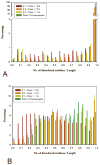Protein tandem repeats - the more perfect, the less structured
- PMID: 20553501
- PMCID: PMC2928880
- DOI: 10.1111/j.1742-464X.2010.07684.x
Protein tandem repeats - the more perfect, the less structured
Abstract
We analysed the structural properties of protein regions containing arrays of perfect and nearly perfect tandem repeats. Naturally occurring proteins with perfect repeats are practically absent among the proteins with known 3D structures. The great majority of such regions in the Protein Data Bank are found in the proteins designed de novo. The abundance of natural structured proteins with tandem repeats is inversely correlated with the repeat perfection: the chance of finding natural structured proteins in the Protein Data Bank increases with a decrease in the level of repeat perfection. Prediction of intrinsic disorder within the tandem repeats in the SwissProt proteins supports the conclusion that the level of repeat perfection correlates with their tendency to be unstructured. This correlation is valid across the various species and subcellular localizations, although the level of disordered tandem repeats varies significantly between these datasets. On average, in prokaryotes, tandem repeats of cytoplasmic proteins were predicted to be the most structured, whereas in eukaryotes, the most structured portion of the repeats was found in the membrane proteins. Our study supports the hypothesis that, in general, the repeat perfection is a sign of recent evolutionary events rather than of exceptional structural and (or) functional importance of the repeat residues.
Keywords: bioinformatics; disordered conformation; evolution; protein structure; sequence analysis.
Figures




Similar articles
-
The unfoldomics decade: an update on intrinsically disordered proteins.BMC Genomics. 2008 Sep 16;9 Suppl 2(Suppl 2):S1. doi: 10.1186/1471-2164-9-S2-S1. BMC Genomics. 2008. PMID: 18831774 Free PMC article.
-
Identification and characterization of tandem repeats in exon III of dopamine receptor D4 (DRD4) genes from different mammalian species.DNA Cell Biol. 2005 Dec;24(12):795-804. doi: 10.1089/dna.2005.24.795. DNA Cell Biol. 2005. PMID: 16332176
-
The repetitive structure of DNA clamps: An overlooked protein tandem repeat.J Struct Biol. 2023 Sep;215(3):108001. doi: 10.1016/j.jsb.2023.108001. Epub 2023 Jul 17. J Struct Biol. 2023. PMID: 37467824
-
TAPO: A combined method for the identification of tandem repeats in protein structures.FEBS Lett. 2015 Sep 14;589(19 Pt A):2611-9. doi: 10.1016/j.febslet.2015.08.025. Epub 2015 Aug 29. FEBS Lett. 2015. PMID: 26320412 Review.
-
In search of the boundary between repetitive and non-repetitive protein sequences.Biochem Soc Trans. 2015 Oct;43(5):807-11. doi: 10.1042/BST20150073. Biochem Soc Trans. 2015. PMID: 26517886 Review.
Cited by
-
Large-scale analysis of intrinsic disorder flavors and associated functions in the protein sequence universe.Protein Sci. 2016 Dec;25(12):2164-2174. doi: 10.1002/pro.3041. Epub 2016 Oct 25. Protein Sci. 2016. PMID: 27636733 Free PMC article.
-
Mutation and selection processes regulating short tandem repeats give rise to genetic and phenotypic diversity across species.J Evol Biol. 2023 Feb;36(2):321-336. doi: 10.1111/jeb.14106. Epub 2022 Oct 26. J Evol Biol. 2023. PMID: 36289560 Free PMC article. Review.
-
DECIPHER: harnessing local sequence context to improve protein multiple sequence alignment.BMC Bioinformatics. 2015 Oct 6;16:322. doi: 10.1186/s12859-015-0749-z. BMC Bioinformatics. 2015. PMID: 26445311 Free PMC article.
-
Diversity and features of proteins with structural repeats.Biophys Rev. 2023 Sep 7;15(5):1159-1169. doi: 10.1007/s12551-023-01130-0. eCollection 2023 Oct. Biophys Rev. 2023. PMID: 37974986 Free PMC article. Review.
-
Effect of Strain Rate on Single Tau, Dimerized Tau and Tau-Microtubule Interface: A Molecular Dynamics Simulation Study.Biomolecules. 2021 Sep 4;11(9):1308. doi: 10.3390/biom11091308. Biomolecules. 2021. PMID: 34572521 Free PMC article.
References
-
- Pellegrini M, Marcotte EM, Yeates TO. A fast algorithm for genome-wide analysis of proteins with repeated sequences. Proteins. 1999;35:440–446. - PubMed
-
- Fraser RDB, MacRae TP. Conformation in fibrous proteins and related synthetic polypeptides. Academic Press; London and New York: 1973.
-
- Yoder MD, Lietzke SE, Jurnak F. Unusual structural features in the parallel beta-helix in pectate lyases. Structure. 1993;1:241–251. - PubMed
-
- Kobe B, Kajava AV. The leucine-rich repeat as a protein recognition motif. Curr Opin Struct Biol. 2001;11:725–732. - PubMed
Publication types
MeSH terms
Substances
Grants and funding
LinkOut - more resources
Full Text Sources

